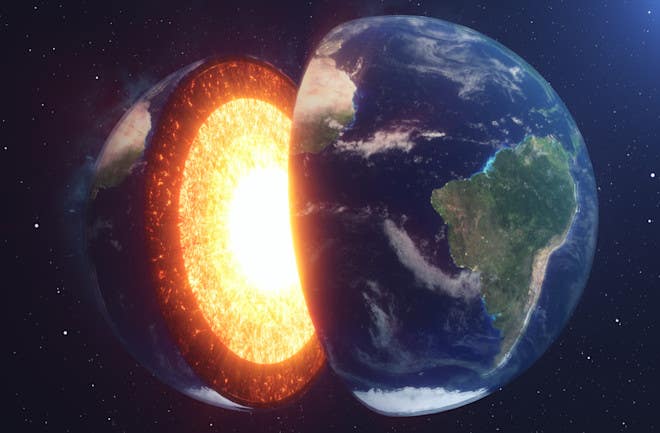Scientists discover strange mantle zones that challenge current understanding of plate tectonics
Scientists using full-waveform inversion have uncovered strange, deep-Earth structures that could reshape how we understand Earth’s mantle.

New wave imaging reveals hidden structures in Earth’s mantle, challenging old tectonic theories. (CREDIT: Rost9 / Shutterstock)
Seismic waves from earthquakes have always offered a window into Earth’s hidden interior. For decades, researchers believed they had a firm grasp on how these waves revealed the rocky mantle’s secrets.
But recent findings are shaking up that belief. Thanks to a new imaging method called full-waveform inversion, geophysicists now realize that Earth’s mantle may be far more mysterious than previously thought.
A Deeper Look into Earth's Mantle
Beneath your feet lies the mantle, a thick layer of rock stretching down almost 2,900 kilometers. This part of the planet plays a crucial role in shaping surface features like mountains and volcanoes, and it drives plate tectonics through slow-moving convection currents.
Scientists have long known that different materials in the mantle affect the speed of seismic waves. Faster wave speeds usually suggest colder or denser rock, while slower speeds point to hotter or lighter material.
Traditionally, geophysicists used a method called travel-time tomography to track these waves and build images of the mantle. This method relies on measuring how long it takes earthquake waves to travel from one point to another. But travel-time tomography has limits. It mostly uses just a few types of waves and depends heavily on the location of earthquake sources and seismic recording stations. That means large areas, especially under oceans or deep inside continents, often remain unclear.
To fill in those gaps, a team of researchers at ETH Zurich and the California Institute of Technology turned to full-waveform inversion, or FWI. This method doesn’t just track a wave’s arrival time—it examines the entire wave as it moves through the Earth. It’s like switching from black-and-white to high-definition color. The team used the Piz Daint supercomputer in Lugano to process this enormous amount of data.
What they found turned heads across the geoscience community.
Unexpected Discoveries
The new global model revealed many previously unseen areas where wave speeds were higher than expected. These "positive wave speed anomalies" suggest the presence of colder or denser material. In the past, such anomalies were usually linked to subduction zones—places where one tectonic plate slides beneath another. In those zones, slabs of oceanic crust plunge into the mantle, creating distinct seismic signatures.
Related Stories
However, many of the new anomalies were located far from any known subduction zones. For example, one large anomaly sits under the western Pacific Ocean, between 900 and 1,200 kilometers deep. This area has no geological record of past subduction, leaving scientists puzzled.
“Apparently, such zones in the Earth's mantle are much more widespread than previously thought,” said Thomas Schouten, a doctoral student at the Geological Institute of ETH Zurich and lead author of the study, published in Scientific Reports. He added, “That’s our dilemma. With the new high-resolution model, we can see such anomalies everywhere. But we don’t know exactly what they are.”
Schouten believes these wave speed anomalies may not be due to cold slabs of crust alone. Instead, they might be linked to other materials that have remained deep in the Earth for billions of years. One possibility is ancient silica-rich rock left over from when the mantle first formed. Another is that certain mantle flows have caused iron-rich rocks to collect over time.
ETH Professor Andreas Fichtner, who developed the new model with his research group, compares the findings to a doctor using a better imaging tool for the first time. “Then if you give him a new, better examination tool, he suddenly sees an artery in the buttock that doesn’t really belong there,” he said. “That’s exactly how we feel about the new findings.”
Moving Beyond Old Models
In the past, the connection between positive wave speed anomalies and subducted slabs was strong enough that geologists used it to map ancient plate movements. These models helped explain how continents drifted, where past earthquakes occurred, and even what Earth's atmosphere might have looked like millions of years ago.
But the new study shows that this approach may be flawed. The FWI results show no significant statistical link between these anomalies and the known locations of past subduction. This means some earlier models of Earth's plate history might need a second look.
“Not all positive wave speed anomalies in the lower mantle are thermal anomalies resulting from slabs that subducted in the last 200 million years,” Schouten said. “They do not represent a reliable proxy to reconstruct past subduction.”
This revelation changes how scientists interpret the mantle’s structure and the forces shaping the planet. It also underscores the need for more complex models that consider both thermal and chemical differences inside Earth.
Seeing More Through Waves
The way seismic waves move gives scientists important clues, but wave speed alone tells only part of the story. The speed depends on many factors, such as rock composition, temperature, and pressure. This makes interpreting wave data tricky.
“Waves only represent one property—the speed at which they travel,” said Schouten. “We have to calculate the different material parameters that could generate the observed speeds of the different wave types.”
That means future models need to go deeper. Scientists want to move beyond just wave speed and start measuring other material traits. They aim to understand not only where anomalies are, but also what they’re made of and how they got there.
The new FWI method gives researchers a sharper view of Earth’s interior than ever before. By using every type of seismic wave available, they can explore previously hidden parts of the mantle, even under vast oceans and inactive landmasses.
These improvements come at a time when global data coverage is also improving. More seismic stations and better data collection mean researchers can test their models against more real-world events.
What Lies Beneath
Earth still holds many secrets. The mantle, hidden far below your feet, moves and changes over time in ways we’re only starting to understand. With new tools like full-waveform inversion, scientists can now see parts of Earth that were once invisible.
These discoveries don’t just rewrite old theories—they raise new questions. What are these mysterious anomalies? How did they form? And what do they mean for the future of our shifting, restless planet?
As more data comes in and computer models improve, researchers hope to answer these questions. For now, though, it’s clear: Earth’s interior is more complex, more dynamic, and more surprising than anyone imagined.
Note: The article above provided above by The Brighter Side of News.
Like these kind of feel good stories? Get The Brighter Side of News' newsletter.
Joseph Shavit
Head Science News Writer | Communicating Innovation & Discovery
Based in Los Angeles, Joseph Shavit is an accomplished science journalist, head science news writer and co-founder at The Brighter Side of News, where he translates cutting-edge discoveries into compelling stories for a broad audience. With a strong background spanning science, business, product management, media leadership, and entrepreneurship, Joseph brings a unique perspective to science communication. His expertise allows him to uncover the intersection of technological advancements and market potential, shedding light on how groundbreaking research evolves into transformative products and industries.



